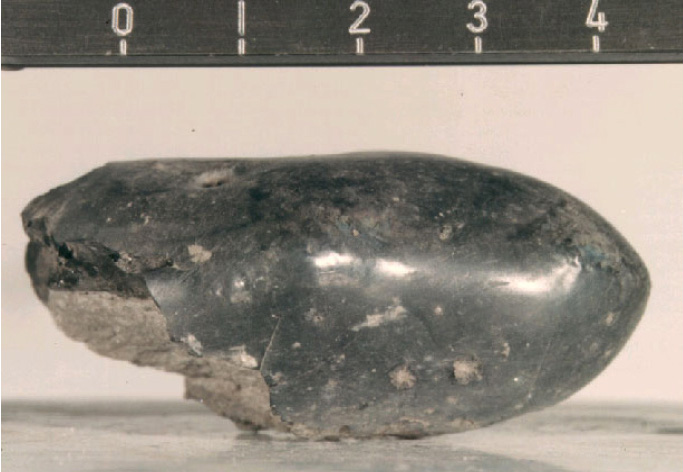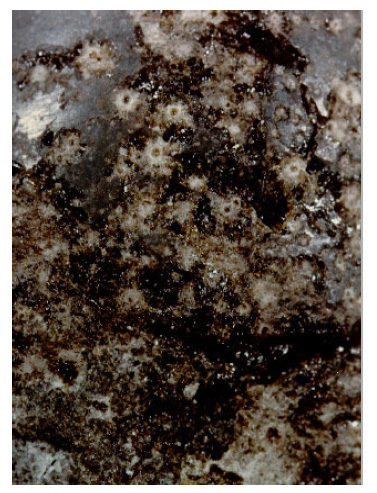
Apollo 16 Sample 64455
Corrected Transcript and Commentary Copyright © 2006 by Eric M. Jones.
All rights reserved.
Photos courtesy Chuck Meyer, NASA Johnson
Last revised 24 January 2006.

NASA Photo S72-40132
showing sample 64455 in the Lunar Receiving Lab.
It is shown resting on the surface that was facing upwards at the time John collected it at Station 4.
From the Catalog of Apollo 16 Rocks, Part 2 (42 Mb PDF )
64455 BASALTIC IMPACT MELT, GLASS COATED 56.7 g
INTRODUCTION: 64455 is a basaltic impact melt with a very thick coating of smooth, dark glass ( S73-22656, 303k ). The basalt is somewhat friable and the bonding between the basalt and the glass coat is generally weak. Along the basalt/glass contact the basalt has been partially melted followed by limited mixing of the melt with the glass coat. The glass coat appears to have once enclosed the entire rock, but a small area on the 'lunar top' has been broken away exposing the basalt. Zap pits are present only on the 'lunar top' surface. Distinct spheroids and dumbells of glass are adhering to, and coalescing with, the exterior surface of the coat. This sample was collected from the northeast rim of a subdued crater on the northeast slope of Stone Mountain.
From the Apollo 16 Lunar Surface Journal:
[John and Charlie are working on Stone Mountain at Station 4, their first EVA-2 geology stop. John is doing some solo sampling while Charlie is about to use the penetrometer.]
144:28:56 Duke: My penetrometer is around here; wait a minute.
144:28:59 Young: Okay. (Pause)
[Charlie circles behind John and goes to the CDR seat where, at some point, he had put the penetrometer.]
144:29:05 Duke: Okay.
144:29:08 Young: Don't step right there, Charlie. Here's a glass splatter.
144:29:12 Duke: Oh, yeah. I see it. A whole big bubble of it, isn't it?
144:29:16 Young: Yeah.
[John and Charlie are near the left rear fender as they work on the penetrometer. John was facing north while he described the glass splatter.]
144:29:18 Duke: Is that on? Yeah, that got it. Thank you.
Beautiful. Okay.
144:29:25 Young: I'm going to grab sample this scrap...this glass splatter behind the Rover, Houston.
144:29:33 Duke: Good. Hey, Tony...John, if you see it, there's one under that rock. Is that the one you're talking about?
144:29:40 Young: Yeah.
144:29:41 Duke: Okay.
[John's cross-Sun 'befores' of the glass splatter are AS16-107-
17455 and
17456. Note that he has planted his tongs while he takes the picture and gets a sample bag ready. He is working at the back of the Rover near the right rear wheel. There are no 'after' pictures of this sample.]
[Charlie re-positions the reference plate on the penetrometer and goes off-camera to the right.]
144:29:42 Duke: Tony, can I start on number 5 on the
penetrometer?
144:29:44 England: Okay, that's fine.
144:29:49 Duke: Okay. I'm going up out of this crater, up on the top part of it.
144:29:57 Young: And that's going into bag 397, Houston.
144:30:00 England: Okay, 397.

This detail from NASA Photo S73-22656, taken in the Lunar Receiving Lab after the mission shows zap pits in the 'lunar top' of sample 64455. The 'lunar top' was the surface facing the sky at the time the sample was collected. Each of the zap pits is the product of a high-speed micrometeorite impact and consists of a dark, glass-lined pit surrounded by a lighter-colored spall zone.


